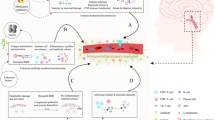Abstract
The aim of the study was to further determine the pathophysiology, clinical course, MRI-features and response to therapy of chronic lymphocytic inflammation with pontine perivascular enhancement responsive to steroids (CLIPPERS), which has recently been proposed as a rare chronic inflammatory central nervous system disorder responsive to immunosuppressive therapy. Three patients with this rare entity underwent serial clinical and bimonthly MRI follow-up over a period of up to 16 months. Extensive laboratory work-up and brain biopsy were performed. Intravenous methylprednisolone or oral dexamethasone was administered as treatment, additionally cyclophosphamide in one patient. Clinically, diplopia, nystagmus, ataxia and facial paresthesia were the cardinal symptoms. Magnetic resonance imaging (MRI) disclosed patchy spot-like gadolinium enhancement in a “salt-and-pepper like appearance” in the pons, midbrain and cerebellum, in two cases with thalamic and in the other with spinal involvement. Brain biopsies demonstrated a predominantly angiocentric but also diffuse infiltration pattern by small mature lymphocytes. Treatment with steroids led to rapid clinical improvement and marked resolution of MRI lesions. As discontinuation of steroids led to clinical relapse, one patient was treated with a further course of steroids and the other with steroids and cyclophosphamide as immunosuppressive therapy. This led to stable remission with only mild clinical residue and normalization of MRI. Extensive laboratory and radiological work-up could not identify any other cause of the disease. Of note, in two cases a marked elevation of IgE in serum was found initially and throughout the course. CLIPPERS seems to be a distinct inflammatory central nervous system disorder. It shows characteristic MRI core features. Extrapontine involvement seems to be frequent. Histologically it is characterised by predominantly angiocentric infiltration by small mature lymphocytes. A pathogenetic relationship between the elevated IgE levels and the perivascular infiltrates can be presumed. It is responsive to immunosuppressive therapy and can require prolonged or maintenance treatment.




Similar content being viewed by others
References
Brinar VV, Habek M (2008) Isolated central nervous system sarcoidosis: a great mimicker. Clin Neurol Neurosurg 110:939–942
Drier A, Bonneville F, Haroche J, Amoura Z, Dormont D, Chiras J (2010) Central nervous system involvement in systemic diseases: spectrum of MRI findings. J Neuroradiol 37:255–267
Kira J (2002) Atopy and neural damage. Intern Med 41:169–174
Kira J, Isobe N, Kawano Y, Osoegawa M, Ohyagi Y, Mihara F, Murai H (2008) Atopic myelitis with focal amyotrophy: a possible link to Hopkins syndrome. J Neurol Sci 269:143–151
Magalhaes ES, Pinto-Mariz F, Bastos-Pinto S, Pontes AT, Prado EA, deAzevedo LC (2009) Immune allergic response in Asperger syndrome. J Neuroimmunol 216:108–112
Neel A, Pagnoux C (2009) Primary angiitis of the central nervous system. Clin Exp Rheumatol 27:S95–S107
Odaka M, Yuki N, Yamada M, Koga M, Takemi T, Hirata K, Kuwabara S (2003) Bickerstaff’s brainstem encephalitis: clinical features of 62 cases and a subgroup associated with Guillain-Barre syndrome. Brain 126:2279–2290
Osoegawa M, Ochi H, Kikuchi H, Shirabe S, Nagashima T, Tsumoto T, Tamura Y, Yamabe K, Takahashi H, Iwaki T, Kira J (2003) Eosinophilic myelitis associated with atopic diathesis: a combined neuroimaging and histopathological study. Acta Neuropathol 105:289–295
Osoegawa M, Ochi H, Minohara M, Murai H, Umehara F, Furuya H, Yamada T, Kira J (2003) Myelitis with atopic diathesis: a nationwide survey of 79 cases in Japan. J Neurol Sci 209:5–11
Passarin MG, Wen PY, Vattemi E, Buffone E, Ghimenton C, Bontempini L, Ottaviani S, Musso AM, Pedersini R (2010) Intravascular lymphomatosis and intracerebral haemorrhage. Neurol Sci 31:793–797
Pittock SJ, Debruyne J, Krecke KN, Giannini C, van den Ameele J, De Herdt V, McKeon A, Fealey RD, Weinshenker BG, Aksamit AJ, Krueger BR, Shuster EA, Keegan BM (2010) Chronic lymphocytic inflammation with pontine perivascular enhancement responsive to steroids (CLIPPERS). Brain 133:2626–2634
Poe LB, Dubowy RL, Hochhauser L, Collins GH, Crosley CJ, Kanzer MD, Oliphant M, Hodge CJ Jr (1994) Demyelinating and gliotic cerebellar lesions in Langerhans cell histiocytosis. Am J Neuroradiol 15:1921–1928
Yavuz H, Chee R (2010) A review on the vascular features of the hyperimmunoglobulin E syndrome. Clin Exp Immunol 159:238–244
Acknowledgments
We gratefully acknowledge Prof. M. Forsting and Dr. C. Möller-Hartmann, Dept. of Neuroradiology, University of Essen for providing MRI material and interpretation and Prof. W. Nacimiento for referring patient 3.
Conflict of interest
The authors declare that they have no conflict of interest.
Author information
Authors and Affiliations
Corresponding author
Rights and permissions
About this article
Cite this article
Kastrup, O., van de Nes, J., Gasser, T. et al. Three cases of CLIPPERS: a serial clinical, laboratory and MRI follow-up study. J Neurol 258, 2140–2146 (2011). https://doi.org/10.1007/s00415-011-6071-4
Received:
Revised:
Accepted:
Published:
Issue Date:
DOI: https://doi.org/10.1007/s00415-011-6071-4




